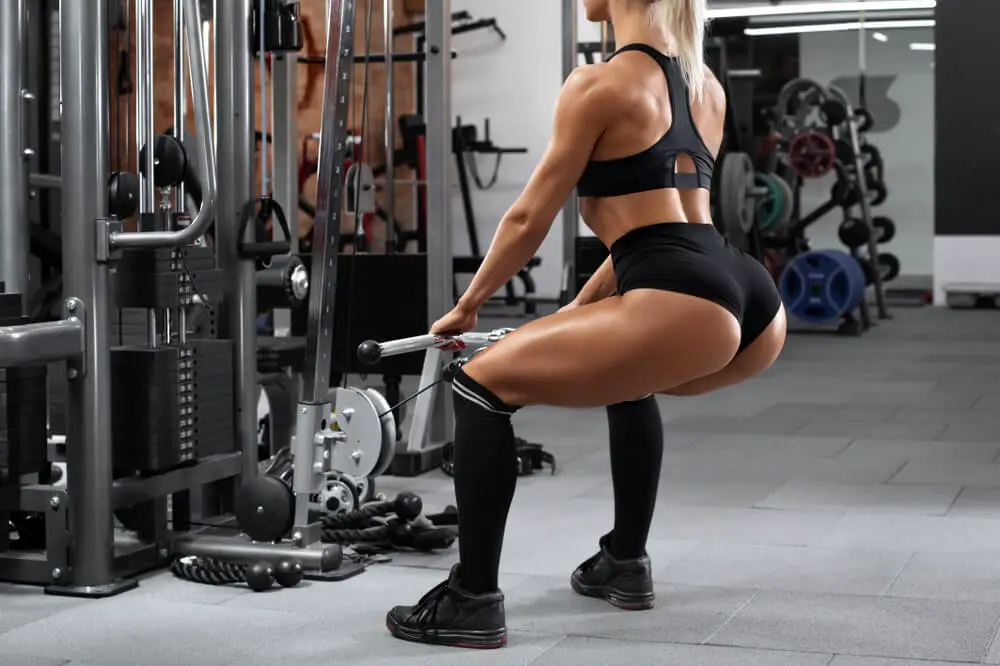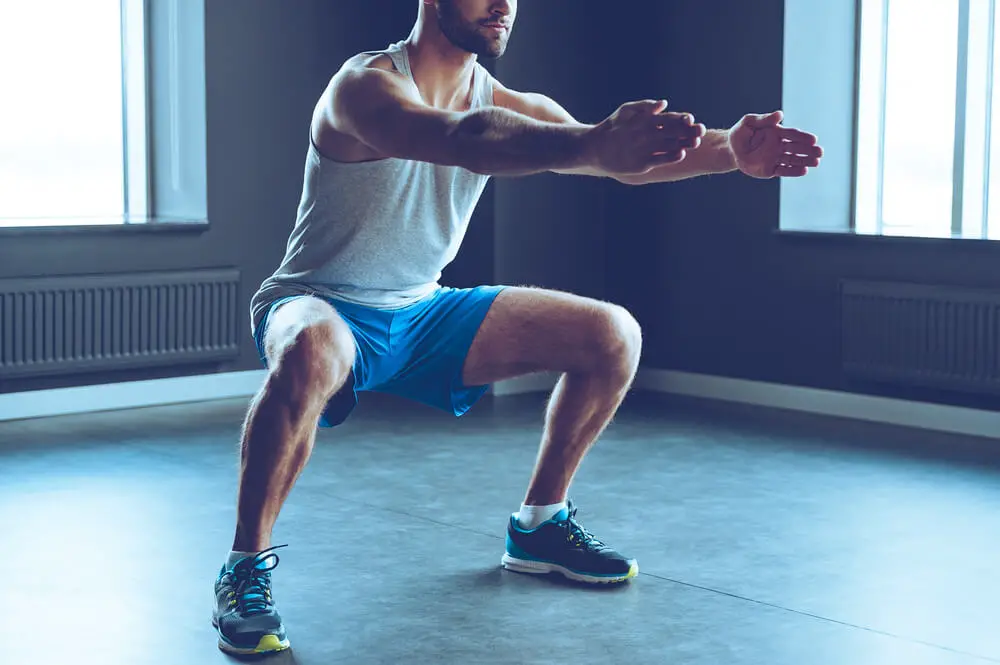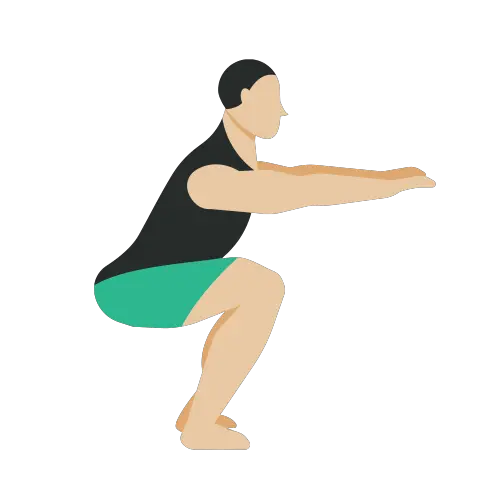Let’s talk about cable squats, how to do them, their benefits and consequences. Cable squats are a fantastic compound exercise that engages multiple muscle groups simultaneously. By using the cable machine, you’ll add resistance to the traditional squat movement, intensifying its effectiveness.
What is a Cable Squat?
Cable Squat is an exercise that targets your middle back, lats and quadriceps. Moreover, it also involves abs, biceps, calves and hamstrings.
It’s one of the best exercises to build lower body and core strength.
How to do Cable Squat?
- Stand facing the cable machine with your feet shoulder-width apart.
- Grab the handles attached to the low pulley with an overhand grip.
- Keep your chest up, back straight, and core engaged as you lower into a squat position.
- Drive through your heels to return to the starting position, squeezing your glutes at the top.
- Repeat for the desired number of reps.
Below is a quick video of cable squat:
Step-by-step Cable Squat Video
Cable Squats Muscles Worked:
- Targets quadriceps, hamstrings, glutes, and calves.
- Improves lower body strength and stability.
- Enhances overall muscle definition.
Benefits Of Cable Squats
Cable squats offer several benefits for your lower body, including:
1. Strengthening Your Muscles
Cable squats target your glutes, quads, hamstrings, and calves, which are all essential for lower body strength and power. By performing this exercise regularly, you can increase your muscle mass, enhance your muscular endurance, and improve your overall strength.
2. Improving Your Balance and Stability
Cable squats require you to maintain your balance and stability while performing the movement, which can help improve your overall balance and stability. This can be especially beneficial for older adults or those who have balance issues.
3. Enhancing Your Athletic Performance
Cable squats can improve your athletic performance by strengthening the muscles needed for running, jumping, and other explosive movements. Additionally, the exercise can help increase your flexibility and range of motion, which can be beneficial for various sports.
Cable Machine Squats
Cable Machine Squats are very easy in comparison to the normal squats for a beginner.
This is because when you are doing a normal squat, you need to learn balancing and it requires a lot of practice to start doing the squats in this way.

But if we talk about cable machine squats, it’s easier to balance yourself while you are bending down. It is so because the cable machine squats require you to hold the strings in your hands. As the cable tries to pull you, it becomes easier for you to bend down and balance your body.
Light Weight Squats
Lightweight squats are mostly suggested for beginners who have never done squats. The main benefit of doing light weight squats is its effectiveness. If you are a beginner, you must first focus on learning the correct technique and then going for the heavy weights. In a recent study, it was found that doing squats for 8 weeks, reduced body fat by 4 percent. So consider adding squats in your schedule, but with lightweight in the beginning.
How do you do squats with a cable machine?
Squats with cable machines can be done very easily if you are in a GYM or you have the cable machine at home.
So let’s see how you do squats with a cable machine:
Step 1:
Hold the cable in each hand and then stand away from the cable machine so that the slack tightens. Make sure to keep your core tight and back straight in this position.
Step 2:
Drive your hips back while bending your knees and keeping the chest up.
Step 3:
Pull the handles leading with your elbow while standing back up. Ensure to tighten the back muscles in this position and then return handles to the starting position.
Step 4:
Repeat steps 1 to 3.
You can watch all four steps of doing cable squats below:
Cable Squats Effectiveness

Though cable squats are easier to do than the normal squats, it’s not as effective as the other squats. This is because a normal squat challenges you to stabilize your body but when you are doing it with a machine it reduces the instability. So if you do a normal squat or a squat with weight, you’ll see better results than the cable squat.
Cable Squats Bodybuilding
Other squats may be more effective than cable squats, but still, cable squats are used by many bodybuilders. If you want to take full benefit of these cable squats bodybuilding, you need to add on a few variations of it. Let’s see some of the ways in which you can do that.
Add Cable Lunges
Description:
Lunges are a staple in any leg workout, but adding cables takes them to the next level by providing constant tension throughout the movement.
How to Perform:
- Stand facing away from the cable machine with the handle attached to the ankle strap on your front foot.
- Take a large step forward with your other foot, lowering your back knee towards the ground.
- Keep your front knee aligned with your ankle and your torso upright.
- Push through your front heel to return to the starting position.
- Repeat on the other leg.
Benefits:
- Targets quadriceps, hamstrings, glutes, and calves.
- Improves balance and coordination.
- Helps correct muscle imbalances between legs.
Add Cable Deadlifts
Description:
Deadlifts are renowned for their ability to build lower body strength and power. Using the cable machine adds a unique challenge by requiring greater stability and control.
How to Perform:
- Stand facing the cable machine with your feet hip-width apart.
- Grab the handles with an overhand grip and hinge at the hips, keeping your back flat.
- Engage your core and drive through your heels to stand up straight, pulling the handles towards your hips.
- Squeeze your glutes at the top before slowly lowering the handles back down.
- Repeat for the desired number of reps.
Benefits:
- Targets hamstrings, glutes, lower back, and core.
- Promotes proper lifting mechanics and posture.
- Minimizes strain on the lower back compared to traditional deadlifts.
Add Cable Calf Raises
Description:
Don’t neglect your calf muscles in your quest for stronger legs. Cable calf raises provide a focused contraction that can help you achieve greater calf definition and strength.
How to Perform:
- Attach the handle to the lowest setting on the cable machine.
- Stand facing the machine with the balls of your feet on the edge of a platform or step.
- Hold the handle for balance support and rise up onto your toes, lifting your heels as high as possible.
- Slowly lower your heels back down, feeling a stretch in your calf muscles.
- Repeat for the desired number of reps.
Benefits:
- Targets the gastrocnemius and soleus muscles in the calves.
- Helps prevent muscle imbalances between the calves and other leg muscles.
- Enhances ankle stability and proprioception.
Cable Squats Bodybuilding For Glutes
Though all the squats target your glutes, there are many ways of doing the squats. By adding these other varieties of cable squats for the glutes, you will see better results. Many of you want great thighs and hips, so here is how you can do cable squats for your glutes.
Cable Squats Bodybuilding (Donkey Kicks For Glutes)
Donkey kicks aren’t actually squats, but if you combine it with your cable squats, you will start getting better glutes in just a few days. So let’s see a quick video and learn how to do donkey kicks for glutes.
Cable Squats With Rope
Another great way doing squat is with a rope. Here’s how you can do cable squats with rope easily.
V Bar Cable Squats
You must have already got an idea through this post that cable squats can be done in different ways. Here’s how you do a V Bar Cable Squats:
Cable Squats Alternatives
Definitely, the best option is doing normal squats. But let’s say you don’t want to do a cable squat anymore or just want to have more options for your leg day, then here are some cable squats alternatives to try:
- Banded Lateral Walk
- Single-Leg Deadlift
- Romanian Dead Lift
- Glute Bridge
- Lunges
- Branded Hip Drive
- Donkey Kicks
Squats burn 35 calories per minute on average.
You should start with 90 squats in 3-4 sets and then gradually increase the weight or reps.
Body weight squats are squats done without lifting any weight. You do it with your own body weight.
New Cable Squats Variations
If you want to switch up your cable squats, try these variations:
1. Single-Leg Cable Squats
Performing cable squats with one leg can increase the challenge and work your muscles differently. To perform this variation, attach the cable handle to one ankle and hold onto something for balance with one hand.
2. Cable Squat Jumps
For a more explosive movement, try adding a jump to your cable squats. Squat down as low as you can, then explode upwards, jumping off the ground. Land softly and repeat for the desired number of repetitions.
3. Sumo Cable Squats
Sumo cable squats are performed with a wider stance, which works your inner thighs and glutes more than traditional squats. Stand with your feet wider than shoulder-width apart, and turn your toes out slightly. Perform a cable squat as normal, keeping your knees in line with your toes.
To Conclude
Cable squats are really great if you want to improve your lower body strength. In this blog post I told you everything about cable squats and the different ways of doing it. Incorporating cable machine exercises into your leg workout routine can take your strength and muscle development to new heights. By performing cable squats, lunges, deadlifts, and calf raises with proper form and intensity, you’ll see significant improvements in both strength and definition. Don’t hesitate to add these exercises to your next gym session for stronger, more sculpted legs. Want learn more forms of squat? Check out pistol squat, dragon squat, curtsy squat, curtsy lunges or simply check out out squats tutorials page.

